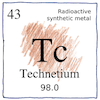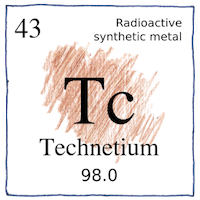Palermo—Emilio Segrè, Carlo Perrier
elements

|
Technetium
The missing element with atomic number 43 was difficult to find because only traces exist naturally on Earth. They named it after the Greek word meaning ‘artificial’ because it was the first man-made element to be found. It was found in a molybdenum foil deflector discarded from Ernest Lawrence’s cyclotron in Berkeley. Lawrence mailed the radioactive foil to Emilio Segrè and Carlo Perrier in Palermo who chemically isolated a couple of isotopes, particularly isotopes technetium-95m and technetium-97.
Atomic number 43
Emilio and Glenn T. Seaborg later found the isotope technetium-99m, widely used today for medical diagnostics. The “m” after the atomic weight signifies the isotope is metastable, not decaying promptly, but in this case with a half-life of six hours.
Unstable stuff
Technetium decays; it doesn’t matter what isotope you have, it’s a sandcastle, a house of cards that tumbles, or pops.



Many other scientists thought that they had found element 43; however, their work was not reproducable, mainly because, at least for most of them, they had found something else.
See also in The book of science:
Readings in wikipedia:
Other readings: